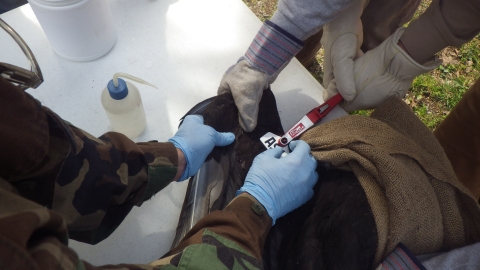While raising trout is our specialty at the Norfork National Fish Hatchery, we welcome every opportunity to dive into other factions of conservation. Recently, the United States Department of Agriculture chose the hatchery as a sample site for a black vulture study. They are frequent visitors of the hatchery grounds, so it was a great spot for their study. The study was focused in the Northern Arkansas/Southern Missouri area. Bio-tech Creed Chapman and Isaac Marler, a young volunteer at the hatchery, assisted the USDA with their work.
Black vultures play an important role in our ecosystem by eliminating dead animals, but they can also be a nuisance in some situations. They have been known to attack calves on farms, cause damage to people's vehicles, and even cause problems for electrical companies. The majority of issues occur when these birds congregate in large numbers and spend a great deal of time in one area. Black vultures are protected by the Migratory Bird Treaty Act of 1918 and cannot be killed without a depredation permit. So, other management practices are necessary in many cases.
The study involved tagging black vultures, fitting select birds with telemetry (tracking) units, and taking blood samples. This of course meant some means of capture were necessary. In this case, a special enclosure was used. This enclosure allowed birds to enter freely, but the design hindered their ability to exit.
All of the birds sampled received white wing tags with their own individual Identifiers (numbers/letters). These tags are easily visible from the ground and have minimal impact on the birds flight. At the hatchery, 7 black vultures also received telemetry units. The travel patterns of those birds will be actively monitored by the USDA. Nuisance control methods were also tested at the site. One goal of the study is to examine the reactions the vultures exhibit after nuisance control methods are utilized. It is important to figure out whether these methods are successful at deterring nuisance birds. This will help us use the most efficient, effective, and humane practices possible. The hatchery is a good test site as black vultures are highly attracted to the area.
There have been several other articles written about the ongoing study, so surfing the web should provide more details if your curiosity is peaked. If you happen to spot one of the wing-tagged vultures, you can report sightings to USDA's Eric Tillman at Eric.A.Tillman@usda.gov. We will also be keeping an eye on the study, so you can keep an eye out for more articles or related posts on The Norfork National Fish Hatchery's Facebook page.




